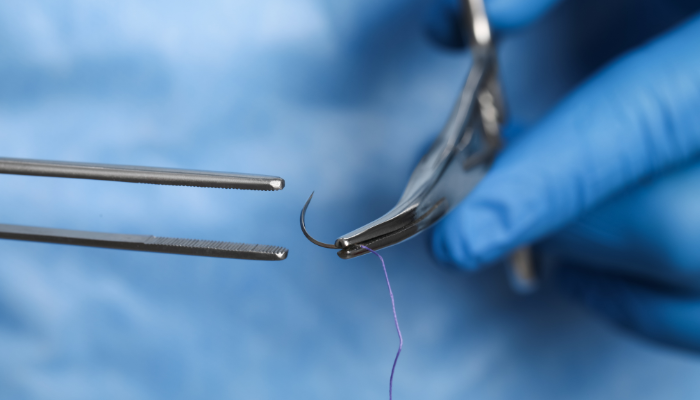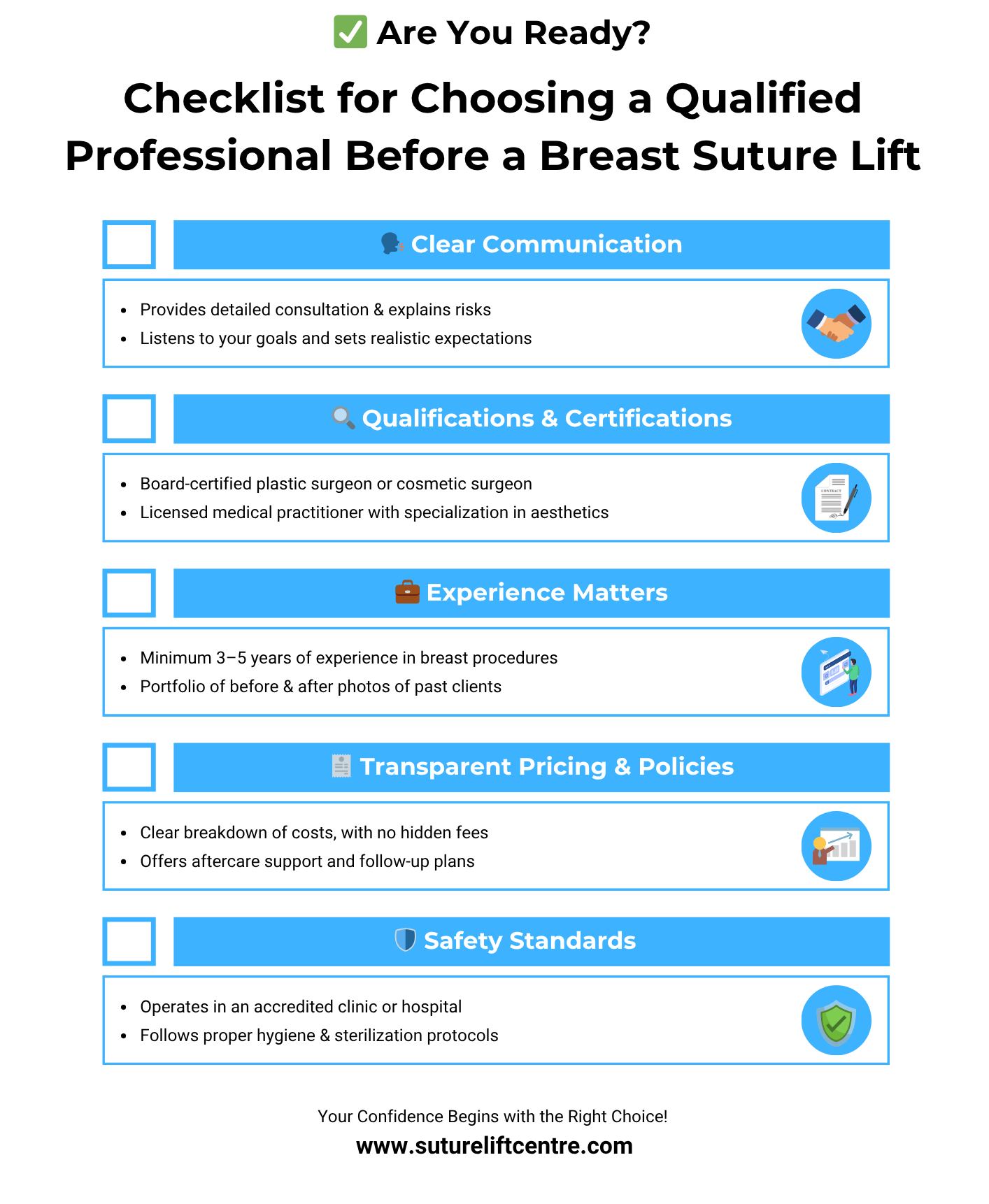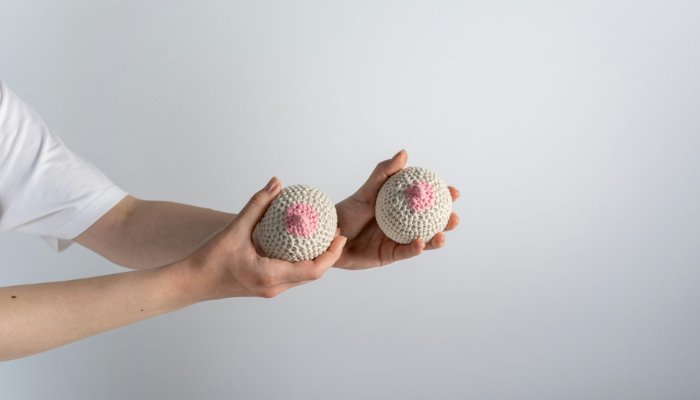So, you are thinking about a breast suture lift, or maybe you have just had one. It is natural to wonder about what happens next. This article is all about helping you understand what to expect after a breast suture lift.
We will go over everything from how the procedure works to what recovery looks like and how to keep your results looking good for as long as possible. The aim is to give you clear, simple information so you feel prepared and confident about your journey.
Key Takeaways
- A breast suture lift is a less invasive way to lift and shape breasts, using special threads.
- Recovery is generally quicker than traditional surgery, but following your surgeon’s advice is really important.
- Knowing what to expect during suture removal helps make the process smooth and easy.
- Good aftercare, like managing swelling and keeping your skin healthy, helps with healing and results.
- Results can last a good while, and looking after yourself helps keep that enhanced look.
Understanding the Breast Suture Lift Procedure

What Is a Breast Suture Lift?
In simple terms, it’s a minimally invasive procedure designed to lift and reshape your breasts without the need for extensive surgery.
Special threads are inserted under the skin to provide support and a subtle lift. It’s becoming quite popular because it’s less invasive than traditional methods.
How Does the Procedure Work?
Usually, you’ll receive a local anaesthetic to numb the area. Then, the practitioner makes small incisions, typically around the breast. Using a needle, they insert threads made of materials like PDO (polydioxanone) or PLLA (poly-L-lactic acid).
These threads have tiny barbs or cones that grip the tissue, allowing the practitioner to gently lift and reposition the breast. Once the threads are in place, they’re tightened to achieve the desired lift, and the ends are trimmed.
The threads not only provide an immediate lift but also stimulate collagen production over time, which helps to improve skin firmness. The whole thing usually takes about an hour or two, and you can usually go home the same day.
Expected Results from a Suture Lift
This procedure offers a subtle lift and improved breast shape, rather than a dramatic transformation. You’ll likely see a noticeable difference in the upper breast area, with a more rounded and lifted appearance.
The results tend to look quite natural, which is a big plus for many people. It’s worth noting that results can vary from person to person. Factors like skin quality, breast size, and the practitioner’s skill all play a role in the final outcome.
It’s always best to have a thorough consultation to discuss your specific goals and expectations.
It’s important to have realistic expectations. A suture lift provides a subtle enhancement, and the longevity of the results can vary. Regular follow-up appointments are key to monitoring your progress and ensuring you’re happy with the outcome.
Safety Considerations for Breast Suture Lifts
Breast suture lifts are gaining traction as a less invasive alternative to traditional breast augmentation. The appeal of minimal downtime and the absence of significant scarring is understandable.
However, like any cosmetic procedure, it’s vital to consider the safety aspects. It’s not just about the potential results; it’s about understanding the risks involved, what the recovery entails, and whether it’s the right choice for you.
Assessing the Safety of the Procedure
So, how safe is a breast suture lift? A lot of it boils down to the experience and qualifications of the practitioner performing the procedure. It’s absolutely crucial to choose someone who is properly trained and has a solid understanding of the anatomy involved.
A skilled practitioner will be able to assess your suitability for the procedure, explain the potential risks, and minimise the chances of complications. Make sure you do your homework and check their credentials!
Potential Side Effects and Complications
While breast suture lifts are generally considered low-risk, there are potential side effects and complications to be aware of. These can include:
- Swelling and bruising: This is common in the days following the procedure and usually subsides within a week or two.
- Infection: As with any procedure that involves breaking the skin, there’s a risk of infection. Your practitioner should provide you with aftercare instructions to minimise this risk.
- Suture extrusion: In some cases, the sutures can work their way to the surface of the skin. This may require removal of the suture.
- Asymmetry: It’s possible to experience some asymmetry in the breasts following the procedure. This can sometimes be corrected with further treatment.
- Pain or discomfort: Some patients experience mild pain or discomfort after the procedure, which can usually be managed with over-the-counter pain relief.
It’s important to remember that everyone’s experience is different, and the likelihood of experiencing these side effects can vary. Discuss any concerns you have with your practitioner during your consultation.
The Importance of a Qualified Practitioner

Choosing a qualified and experienced practitioner is paramount. A skilled practitioner will not only minimise the risk of complications but also ensure that you achieve the best possible results. They will be able to assess your individual needs and tailor the procedure accordingly.
They will also provide you with comprehensive aftercare instructions and be available to answer any questions or concerns you may have during your recovery.
Don’t be afraid to ask about their qualifications, experience, and patient testimonials. It’s your body, and you deserve the best possible care.
The Suture Removal Process
What to Expect During Suture Removal
It’s normal to feel a bit apprehensive, but honestly, it’s usually a pretty simple process. The appointment is generally quick, and the actual removal is often less uncomfortable than you might think.
Your surgeon, or a trained nurse, will carefully snip and pull out each suture. You might feel a slight tugging or pulling sensation, but it shouldn’t be painful.
If you’re worried about discomfort, have a chat with your surgeon beforehand; they might suggest taking a mild painkiller beforehand. It’s all pretty straightforward, and before you know it, you’ll be done.
The Importance of Professional Removal
I know it might be tempting to try and remove the sutures yourself – just don’t! It’s really important to have a professional do it. Here’s why:
- Risk of Infection: Professionals use sterile equipment and techniques to minimise the risk of infection.
- Proper Technique: They know exactly how to remove sutures without causing damage to the surrounding skin.
- Avoiding Complications: They can spot any potential problems early and deal with them properly.
Trying to DIY suture removal can lead to complications like infection, scarring, or even reopening the incision. It’s really not worth the risk. Leave it to the experts; they’re trained to do it safely and effectively.
Managing Discomfort During Removal
While suture removal isn’t usually painful, some people might experience a bit of discomfort. Here are a few tips to manage it:
- Communicate: Tell your nurse or surgeon if you’re feeling any pain. They can adjust their technique to make you more comfortable.
- Relax: Try to relax your muscles during the removal. Tension can make you more sensitive to pain.
- Breathe: Focus on your breathing to help you stay calm. Deep, slow breaths can work wonders.
If you’re really worried, ask your surgeon about using a topical numbing cream before the appointment. It can help to reduce any sensitivity and make the process even easier.
Essential Aftercare Practises for Optimal Healing
Now comes the really important bit: looking after yourself properly to make sure you get the best possible results. Don’t worry, it’s not too complicated, and I’m here to guide you through it.
Following Your Surgeon’s Instructions
This is the most important thing, really. Your surgeon knows your specific situation and what’s best for you. Stick to their advice like glue. They’ll give you personalised instructions on everything from cleaning the area to taking any medication.
Don’t be tempted to skip steps or do your own thing – it could really affect your results. If you’re unsure about anything, just give them a ring; they’re there to help.
Managing Swelling and Bruising
Some mild swelling or bruising is normal after a suture lift. Here’s what you can do:
- Cold Compresses: Apply cold compresses to the area for about 15-20 minutes at a time, several times a day, especially in the first few days. This helps reduce swelling and ease any discomfort.
- Elevation: When resting, try to keep your upper body slightly elevated. This can help to minimise swelling.
- Gentle Massage: Your surgeon might recommend gentle massage to help with lymphatic drainage. Follow their instructions carefully.
Promoting Skin Health and Hydration
Looking after your skin is key to a good recovery and long-lasting results. Here’s how:
- Stay Hydrated: Drink plenty of water to keep your skin hydrated from the inside out.
- Gentle Skincare: Use gentle, fragrance-free skincare products. Avoid anything harsh or abrasive.
- Sun Protection: Protect your skin from the sun. Wear sunscreen and avoid prolonged sun exposure.
Remember, everyone heals at their own pace. Be patient with yourself, and don’t hesitate to reach out to your surgeon if you have any concerns. Proper aftercare is key to achieving the best possible results from your breast suture lift.
Long-Term Results and Maintenance
Now, you’re probably wondering how long you can expect to enjoy the results. Suture lifts are designed to be a lasting solution, offering a more permanent lift compared to temporary thread lifts.
However, it’s important to have realistic expectations. The effects can last for several years, but factors like your skin’s natural elasticity, lifestyle, and the natural ageing process will influence the longevity of the lift.
Think of it as a long-term investment in your appearance, but one that requires some upkeep to maintain.
Stimulating Collagen Production
One of the great things about a suture lift is that it not only provides an immediate lift but also stimulates collagen production. This is key to maintaining a youthful appearance.
As the sutures integrate with your tissue, they encourage your body to produce more collagen, which helps to improve skin firmness and elasticity over time. To further boost collagen production, consider incorporating these into your routine:
- A balanced diet rich in vitamins and antioxidants.
- Topical treatments containing retinoids or peptides.
- Regular facial massage to stimulate blood flow.
Sustaining Your Enhanced Appearance
To really make the most of your breast suture lift and sustain your enhanced appearance, it’s important to adopt a proactive approach.
Here are a few tips to keep in mind:
- Sun Protection: Shield your skin from harmful UV rays by wearing sunscreen daily.
- Healthy Lifestyle: Maintain a stable weight and avoid smoking, as these can impact skin elasticity.
- Skincare Routine: Use high-quality skincare products to keep your skin hydrated and nourished.
- Regular Check-ups: Attend follow-up appointments with your surgeon to monitor your results and address any concerns.
Remember, a suture lift is a fantastic way to achieve a subtle yet effective enhancement. By following these maintenance tips, you can help prolong the results and enjoy your rejuvenated appearance for years to come.
Comparing Suture Lifts to Other Options
Suture Lifts Versus Traditional Surgery
When you’re thinking about a breast lift, it’s easy to get caught up in the different options. Traditional surgery, like a full mastopexy, involves incisions to remove excess skin and reshape the breast tissue. This can give dramatic results, but it also means a longer recovery and more noticeable scarring.
A suture lift, on the other hand, is much less invasive. It uses threads to lift and support the breasts, resulting in smaller scars and a quicker return to normal activities. It’s a trade-off: surgery offers more significant changes, while a suture lift provides a subtle enhancement with less downtime.
Suture Lifts Versus Temporary Thread Lifts
So, what’s the difference between a suture lift and a temporary thread lift? Well, it’s all about the threads themselves. Temporary thread lifts use threads that dissolve over time, usually within a few months.
This means the results are short-lived, and you’ll need repeat treatments to maintain the lift. Suture lifts, however, use permanent sutures that provide longer-lasting support.
Here’s a quick comparison:
| Feature | Suture Lift | Temporary Thread Lift |
|---|---|---|
| Thread Type | Permanent | Dissolvable |
| Result Duration | Longer-lasting | Short-lived |
| Invasiveness | Minimally Invasive | Minimally Invasive |
| Collagen Boost | Yes | Yes |
Why Choose a Suture Lift
Choosing the right procedure depends on your goals and expectations. If you’re after a subtle lift with minimal downtime, a suture lift could be ideal. It’s a great option if you want to avoid the risks and recovery associated with surgery.
Plus, the sutures stimulate collagen production, which can improve skin firmness over time. It’s all about finding the right balance between results, recovery, and your personal preferences.
Ultimately, the best way to decide is to chat with a qualified practitioner. They can assess your individual needs and recommend the most suitable option for you. Don’t be afraid to ask questions and express any concerns you might have. Your comfort and satisfaction are what matters most.
Navigating Your Recovery Journey
Recovery after a breast suture lift is a process, and it’s important to approach it with the right mindset and knowledge.
It’s not always easy, but understanding what to expect can make a big difference. Let’s break down some key aspects to help you through this phase.
Minimising Downtime After Your Lift
Let’s be real, nobody wants to spend weeks hiding away after a cosmetic procedure. The good news is that downtime after a suture lift is generally minimal compared to more invasive surgeries.
However, there are things you can do to speed up your recovery and get back to your routine sooner rather than later.
- Rest is key. Avoid strenuous activities for at least a week or two. This doesn’t mean you can’t potter around the house, but skip the gym and heavy lifting.
- Use cold compresses. Applying cold packs to the treated area can help reduce swelling and discomfort. Do this for 15-20 minutes at a time, several times a day, especially in the first few days.
- Sleep on your back. This helps to avoid putting pressure on your breasts and potentially disrupting the sutures.
Listen to your body. If something feels uncomfortable or painful, don’t push it. It’s better to take things slow and steady to ensure proper healing.
Recognising Signs of Complications

While suture lifts are generally safe, it’s important to be aware of potential complications. Knowing what to look out for can help you address any issues quickly and effectively.
Here are some signs that warrant a call to your surgeon:
- Increased pain or swelling: A little discomfort is normal, but if the pain becomes severe or the swelling worsens, it could indicate an infection or other problem.
- Redness or warmth around the incision sites: These are classic signs of infection.
- Fever: A fever is another sign that your body is fighting off an infection.
- Unusual discharge: Any discharge from the incision sites, especially if it’s pus-like or has an odour, should be reported to your surgeon.
The Role of Follow-Up Appointments
Follow-up appointments are a really important part of your recovery journey. They allow your surgeon to monitor your progress, address any concerns, and ensure that you’re healing properly. Think of them as check-ins to keep you on the right track.
At these appointments, your surgeon will:
- Assess your healing: They’ll examine the incision sites to make sure they’re healing well and there are no signs of infection.
- Answer your questions: This is your chance to ask any questions you have about your recovery or the results of your lift.
- Provide further guidance: They may offer additional tips or recommendations to help you optimise your healing and maintain your results.
Don’t skip these appointments! They’re a valuable resource and can help you achieve the best possible outcome from your breast suture lift.
Conclusion
Getting a breast suture lift can really make you feel better about yourself, and knowing what to expect afterwards just makes everything easier. Remember, looking after yourself properly after the procedure is super important for getting the best results.
If you stick to the advice your surgeon gives you, you’ll be well on your way to a smooth recovery and loving your new look. It’s all about taking it easy and letting your body heal.
Frequently Asked Questions
What exactly is a breast suture lift?
A breast suture lift is a special procedure that helps lift and reshape your breasts without needing big surgery. Instead of cutting, tiny threads are put under your skin to give your breasts a gentle lift and better shape. It’s a less invasive way to get a refreshed look.
How does the breast suture lift work?
The procedure involves inserting special medical threads, often made of materials like PDO or PLLA, under the skin. These threads have tiny hooks or cones that grip the breast tissue. Once in place, the doctor gently pulls and tightens the threads to lift and reposition your breasts. These threads also encourage your body to make more collagen, which helps your skin become firmer over time.
What kind of results can I expect from a breast suture lift?
While a breast suture lift offers a noticeable improvement, it’s more about a subtle lift and improved shape rather than a dramatic change. You’ll likely see your upper breast area looking more rounded and lifted, giving a natural and refreshed appearance. The final look depends on things like your skin type and breast size.
Is a breast suture lift a safe procedure?
Yes, a breast suture lift is generally considered safe, especially since it’s less invasive than traditional surgery. However, like any medical procedure, there are some small risks, such as swelling or infection. The most important thing for safety is to choose a highly skilled and experienced doctor to perform the procedure.
What is the recovery period like after a breast suture lift?
The recovery time for a breast suture lift is usually quite quick. Most people can get back to their normal activities within a few days. You might have some mild swelling or bruising, but serious downtime is rare. Your doctor will give you specific instructions to help you heal well, like avoiding heavy lifting for a while.
How long do the results of a breast suture lift typically last?
The results from a breast suture lift can last for a good amount of time, usually anywhere from 9 months to 5 years, depending on the type of threads used and how your body reacts. The threads also help your skin produce more collagen, which can make the results last even longer by improving your skin’s firmness.




